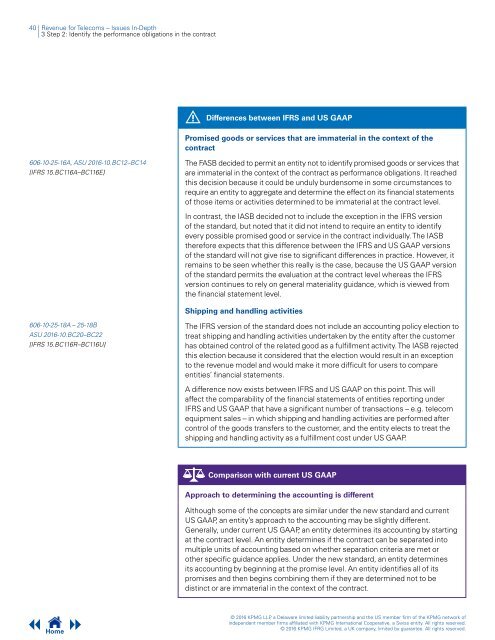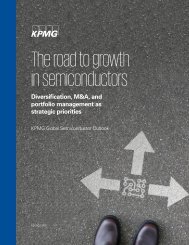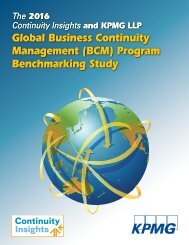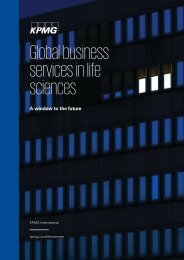Revenue for Telecoms
2cdncba
2cdncba
Create successful ePaper yourself
Turn your PDF publications into a flip-book with our unique Google optimized e-Paper software.
40 | <strong>Revenue</strong> <strong>for</strong> <strong>Telecoms</strong> – Issues In-Depth<br />
| 3 Step 2: Identify the per<strong>for</strong>mance obligations in the contract<br />
Differences between IFRS and US GAAP<br />
Promised goods or services that are immaterial in the context of the<br />
contract<br />
606-10-25-16A, ASU 2016-10.BC12–BC14<br />
[IFRS 15.BC116A–BC116E]<br />
The FASB decided to permit an entity not to identify promised goods or services that<br />
are immaterial in the context of the contract as per<strong>for</strong>mance obligations. It reached<br />
this decision because it could be unduly burdensome in some circumstances to<br />
require an entity to aggregate and determine the effect on its financial statements<br />
of those items or activities determined to be immaterial at the contract level.<br />
In contrast, the IASB decided not to include the exception in the IFRS version<br />
of the standard, but noted that it did not intend to require an entity to identify<br />
every possible promised good or service in the contract individually. The IASB<br />
there<strong>for</strong>e expects that this difference between the IFRS and US GAAP versions<br />
of the standard will not give rise to significant differences in practice. However, it<br />
remains to be seen whether this really is the case, because the US GAAP version<br />
of the standard permits the evaluation at the contract level whereas the IFRS<br />
version continues to rely on general materiality guidance, which is viewed from<br />
the financial statement level.<br />
Shipping and handling activities<br />
606-10-25-18A – 25-18B<br />
ASU 2016-10.BC20–BC22<br />
[IFRS 15.BC116R–BC116U]<br />
The IFRS version of the standard does not include an accounting policy election to<br />
treat shipping and handling activities undertaken by the entity after the customer<br />
has obtained control of the related good as a fulfillment activity. The IASB rejected<br />
this election because it considered that the election would result in an exception<br />
to the revenue model and would make it more difficult <strong>for</strong> users to compare<br />
entities’ financial statements.<br />
A difference now exists between IFRS and US GAAP on this point. This will<br />
affect the comparability of the financial statements of entities reporting under<br />
IFRS and US GAAP that have a significant number of transactions – e.g. telecom<br />
equipment sales – in which shipping and handling activities are per<strong>for</strong>med after<br />
control of the goods transfers to the customer, and the entity elects to treat the<br />
shipping and handling activity as a fulfillment cost under US GAAP.<br />
Comparison with current US GAAP<br />
Approach to determining the accounting is different<br />
Although some of the concepts are similar under the new standard and current<br />
US GAAP, an entity’s approach to the accounting may be slightly different.<br />
Generally, under current US GAAP, an entity determines its accounting by starting<br />
at the contract level. An entity determines if the contract can be separated into<br />
multiple units of accounting based on whether separation criteria are met or<br />
other specific guidance applies. Under the new standard, an entity determines<br />
its accounting by beginning at the promise level. An entity identifies all of its<br />
promises and then begins combining them if they are determined not to be<br />
distinct or are immaterial in the context of the contract.<br />
Home<br />
© 2016 KPMG LLP, a Delaware limited liability partnership and the US member firm of the KPMG network of<br />
independent member firms affiliated with KPMG International Cooperative, a Swiss entity. All rights reserved.<br />
© 2016 KPMG IFRG Limited, a UK company, limited by guarantee. All rights reserved.







